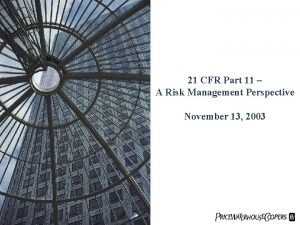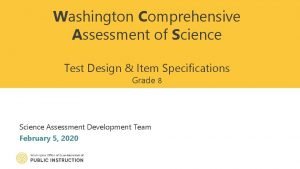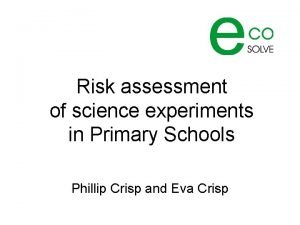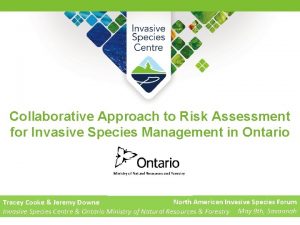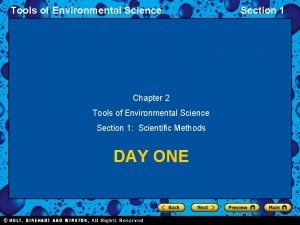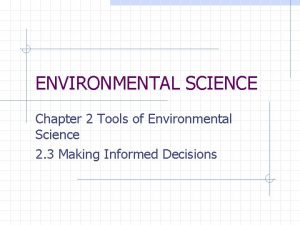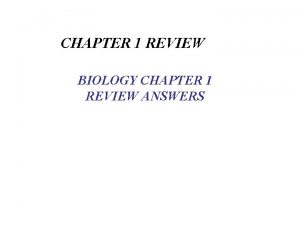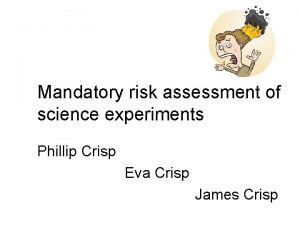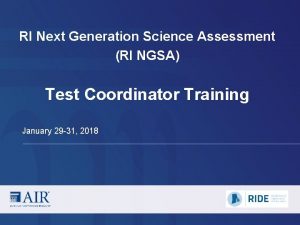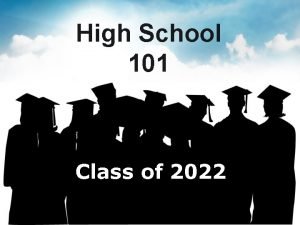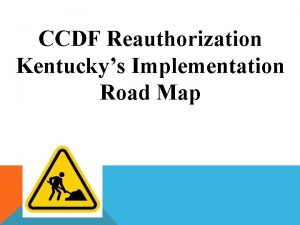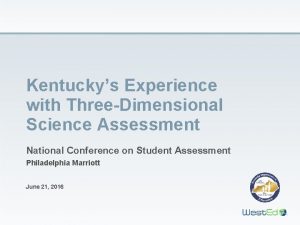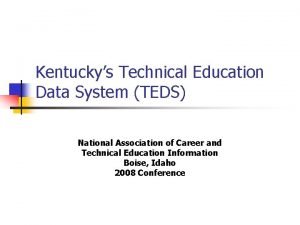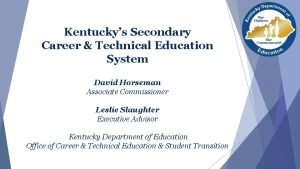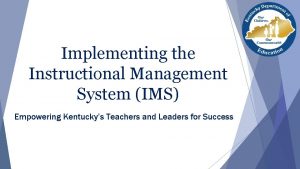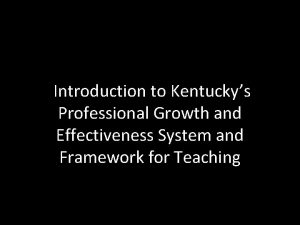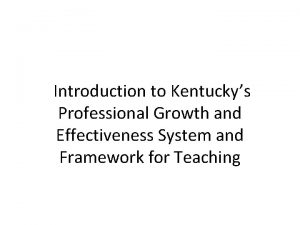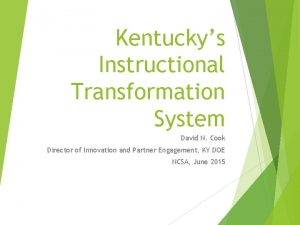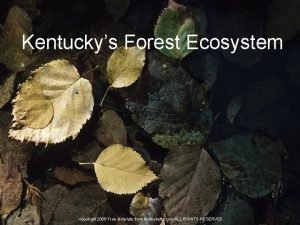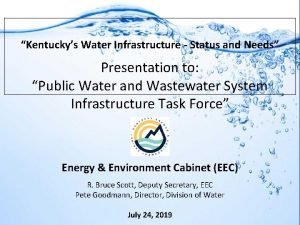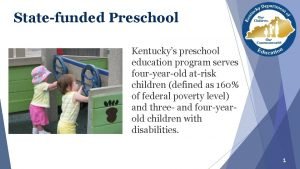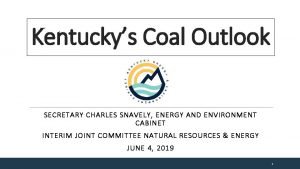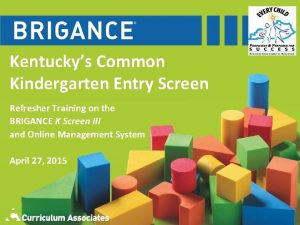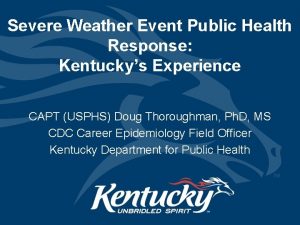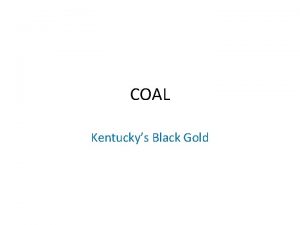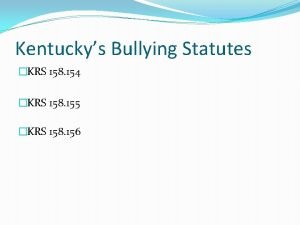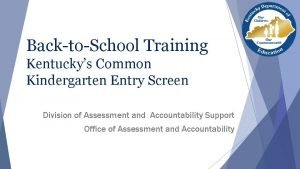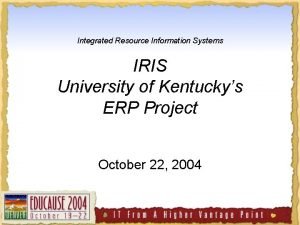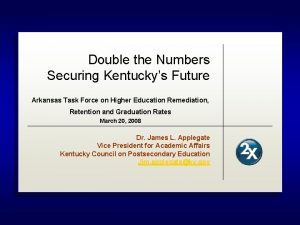Kentuckys Science Assessment System A 3 part System


![Vision of Science Proficiency } [By] the end of 12 th grade, all students: Vision of Science Proficiency } [By] the end of 12 th grade, all students:](https://slidetodoc.com/presentation_image_h2/4f27ab2e7ff85283a8e4d10391fd953a/image-3.jpg)
























- Slides: 27

Kentucky’s Science Assessment System A 3 -part System in Support of 3 -D Standards

Focus Questions } What IS a system of assessments? } Why would an SEA focus beyond the statewide summative? } How can policies drive effective teaching and learning? } How can an SEA walk the talk when they say: We’re from the state and we’re here to help? 2
![Vision of Science Proficiency By the end of 12 th grade all students Vision of Science Proficiency } [By] the end of 12 th grade, all students:](https://slidetodoc.com/presentation_image_h2/4f27ab2e7ff85283a8e4d10391fd953a/image-3.jpg)
Vision of Science Proficiency } [By] the end of 12 th grade, all students: ● ● ● have some appreciation of the beauty and wonder of science; possess sufficient knowledge of science and engineering to engage in public discussions on related issues; are careful consumers of scientific and technological information related to their everyday lives; are able to continue to learn about science outside school; and have the skills to enter careers of their choice, including (but not limited to) careers in science, engineering and technology. 3

A SYSTEM of Science Assessments } Built on teaching and learning in classroom } Each component adds and elicits new evidence of students’ learning } Defensible evidence of student attainment of the standard – as the standard was intended – is generated } Supports different purposes/users/uses Classroom Embedded Assessments Through. Course Tasks PE Statewide Summative Assessment 4

Board on Testing and Assessment (BOTA) The committee encourages a developmental path for assessment that is “bottom up” rather than “top down; ” one that begins with the process of designing assessments for the classroom, perhaps integrated into instructional units, and moves toward assessments for monitoring. (page 8) 5

From a traditional view of … Classroom Assessments • predict Science Standards Common Assessments • predict State Test 6

To: CEA Every day, every student, every year TCT 3 x a year, every student, every year SSA Once per year in grades 4, 7 and high school Provides cumulative, yet not necessarily duplicative information KAS for Science 7

A good assessment system can play a critical role in providing fair and accurate measures of the learning of all students and providing students with multiple ways of demonstrating their competency. (page 9) 8

CEA: Classroom Embedded Assessments Provide opportunities for seeking and interpreting evidence of three-dimensional science learning for use by learners and their teachers to decide where the learners are in their learning, where they need to go and how best to get there KAS for Science 9

TCT: Through Course Tasks Provide snapshots of student learning/ thinking/application (and models of quality 3 -D tasks) of the science standards; teachers working collaboratively analyze students’ work to calibrate expectations and confer on instructional implications/next steps to promote learning KAS for Science 10

Creating the TCTs: } Kentucky teachers from every grade/course selected to develop tasks for each grade K-12 } Tasks were piloted/revised in the developer’s classrooms } Facilitation guides created to accompany each task } Open window November-March for classroom implementation: EVERY teacher of science was asked to administer a task of their choosing } Post-task analysis resulted in the submission to KDE of one single representative sample per grade/course from each district for calibration and quality control 11

Grade 1 TCT Example: SEP/CCC Driven 12

What pattern in the shadows do you observe? What does the pattern tell you about the relationship between the sun and the shadow? 13

The pattern I observed in the shadow chart helped me know this because _______________ 14

SSA: Statewide Summative Assessments Sampling of a school’s science program level of achievement (based on Kentucky Academic Standards for Science) and identify percentage of students meeting expected levels of attainment KAS for Science 15

Creating the Summative: } 40+ Kentucky teachers selected to develop items } Bundled 2 -3 Performance Expectations (PE) from the Kentucky Academic Standards within the context of a phenomenon } Developed “storylines” and stimuli that establish the outline of how the phenomenon will be used to elicit evidence for the PEs } Created clusters of items that provide evidence of student learning of the bundled PEs: ● 6 -7 selected response opportunities ● 2 -3 constructed response questions 16

State Summative Assessment Prototype: Phenomenon-based Cluster 17

State Summative Assessment Prototype 18

Essential Questions for Teaching, Learning and Assessment } What do we expect students to know and be able to do? } How will we know when they are successful? } What will we do to support further/deeper learning – to move all students forward? 19

Process for CEAs/TCTS PLANNING IMPLEMENTING ANALYZING STUDENT WORK Note: Each of these corresponds to research on highly effective teaching, learning and assessment as well as Kentucky’s Framework for Teaching, Domains 1, 3, and 4 20

Policy and Practice Challenges: Rigorous and Aligned 3 -D Tasks/Clusters } A customizable “template” assures the explicit pairing of SEPs that promote exploration of a DCI-based phenomena using a CCC as a sense -making lens. } KY teacher created, vendor supported } Phenomenologically centered to elicit evidence of and transfer of learning 24

Policy and Practice Challenges: Effective Professional Learning Opportunities } Professional learning vs “PD as activity” (leveraged by new PL Standards in regulation) } Intentionality of teachers engaging in the three-step process is key to establishing a focus on highly effective practices that effect student success } Quality over ‘quantity’ (in terms of teacher time, collaboration) 25

Policy and Practice Challenges: Focus on Effectiveness – from preservice throughout career } Involvement of higher ed faculty to develop assessments/support ongoing professional learning } Expectations for effective teaching congruent to effective implementation of system components } Focus on developing collective teacher efficacy 26

2017 Field Test: Lessons Learned (TCT) } Teacher uncertainty regarding formative assessment and TCT—”Do your best” } Emphasis on SEP and CCC as ‘content’ } Phenomena well-received by teachers and students, engagement fosters perseverance } Emphasis on process vs task—quality conversations } Meaningful tasks aren’t created easily 27

2017 Field Test: Lessons Learned (summative) } Phenomena/clusters well-received by teachers and students, engagement fosters perseverance } Storyline approach requires careful attention to reading levels/load } Student engagement dramatically different: students appreciated the storyline/cluster approach } Meaningful clusters aren’t created easily: 30+ hours per cluster rough draft 28

More about Kentucky’s Science Assessment System } http: //education. ky. gov/curriculum/conpro /science/Pages/Science-Assessment. aspx Contacts: Stephen. Pruitt@education. ky. gov Rhonda. Sims@education. ky. gov Sean. Elkins@education. ky. gov Karen. Kidwell@education. ky. gov 29

 You are my favorite subject
You are my favorite subject Addition symbol
Addition symbol Unit ratio definition
Unit ratio definition Brainpop ratios
Brainpop ratios Define technical description
Define technical description Part part
Part part The phase of the moon you see depends on ______.
The phase of the moon you see depends on ______. Minitab adalah
Minitab adalah 21 cfr part 11 risk assessment
21 cfr part 11 risk assessment Earth science regents lab practical
Earth science regents lab practical Branches of science
Branches of science Essential elements of portfolio assessment
Essential elements of portfolio assessment Static assessment vs dynamic assessment
Static assessment vs dynamic assessment Portfolio assessment matches assessment to teaching
Portfolio assessment matches assessment to teaching Washington comprehensive assessment program
Washington comprehensive assessment program Risk assessment for science experiments
Risk assessment for science experiments Risk assessment science example
Risk assessment science example Chapter 2 tools of environmental science
Chapter 2 tools of environmental science Chapter 2 assessment environmental science
Chapter 2 assessment environmental science Chapter 1 chapter assessment the central science
Chapter 1 chapter assessment the central science Biology chapter 1 assessment answers
Biology chapter 1 assessment answers Phillip crisp
Phillip crisp Rhode island ngsa practice test
Rhode island ngsa practice test Chs hcpss
Chs hcpss Natural vs social science
Natural vs social science What are the branches of natural science
What are the branches of natural science Natural science vs physical science
Natural science vs physical science Applied science vs pure science
Applied science vs pure science








